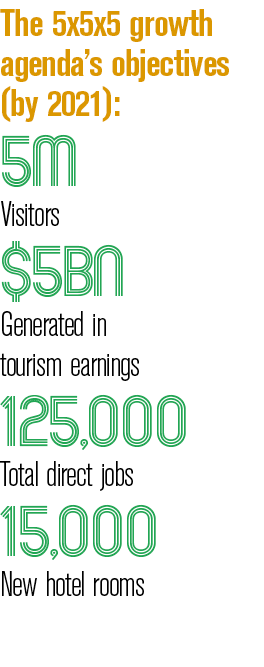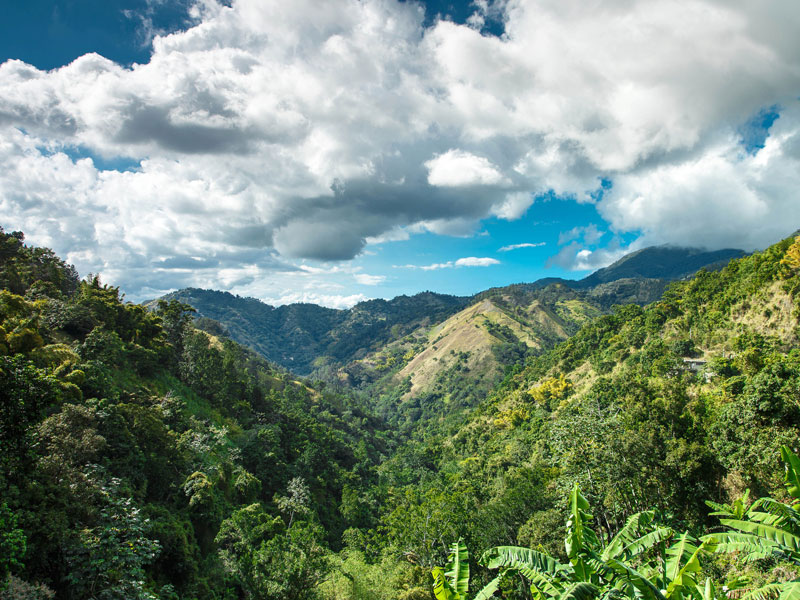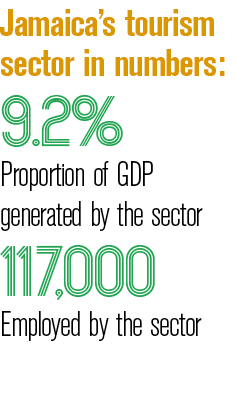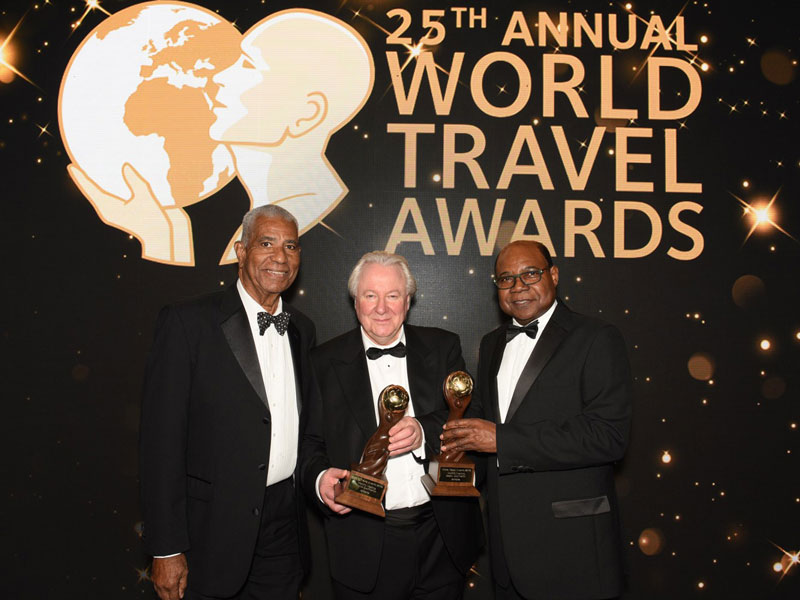
Progress must include everyone. This is the central tenet driving Jamaica’s Ministry of Tourism. The public sector body has developed a framework that will reposition tourism so that it generates higher growth rates in terms of visitor arrivals and revenue.
As one of the largest and fastest-growing economic sectors in the world, tourism is ideally positioned to be a powerful catalyst for socioeconomic development. It is no different in Jamaica, where the sector generated 9.2 percent of the nation’s GDP in 2018 and directly employs 117,000 people. Tourism is indisputably Jamaica’s best bet in its quest to reach economic prosperity.
When Edmund Bartlett took office as Jamaica’s Minister of Tourism in 2016, he committed to “reimagining tourism” in order to boost sector earnings, diversify the tourism product, create opportunities for local entrepreneurs and make Jamaica a more attractive destination for investors. In other words, he will create a more viable and inclusive sector.
Although a small Caribbean island, Jamaica is an internationally recognised brand that knows how to play to its strengths
To drive this mandate, his ministry formulated the 5x5x5 growth agenda to attract five million visitors by 2021, generate $5bn (€4.5bn) in tourism earnings, increase total direct jobs to 125,000 and add 15,000 new hotel rooms. This is just the start of the ambitious plans Bartlett has for the industry. He spoke with European CEO about the ministry’s future aims and why he believes every Jamaican should benefit from the significant success the tourism sector is experiencing.
Pillars of strength
To meet the Ministry of Tourism’s targets, Bartlett has put in place five pillars of tourism growth that are designed to drive expansion, deepen the links between tourism and other economic sectors, and encourage investment in the industry. These pillars consist of creating new products, tapping into new markets, promoting investment, building new partnerships and developing human capital.
Bartlett’s reimagining of tourism has seen the sector boom in the last few years, producing record earnings and arrivals, a more diverse product and greater opportunities for local entrepreneurs. At the same time, it has made Jamaica a more attractive destination for investors. “Our new approach to tourism comes at a time when we are experiencing an increasingly challenging global tourism arena with competition from emerging destinations, shifting travel patterns and volatile economic conditions,” Bartlett explained to European CEO. “Nevertheless, fierce competition offers new opportunities. It forces us to rethink old ways of doing things. It forces us to innovate.” Although a small Caribbean island, Jamaica is an internationally recognised brand that knows how to play to its strengths: this is how the island is differentiating itself from the competition.

Tourism, by its very nature, is a partnership between the government and the private sector, where collaborative leverage can be used to develop, expand and refine a destination’s product range. “We have in place a Tourism Linkages Council, under the Tourism Enhancement Fund (TEF), which is chaired by noted hotelier Adam Stewart,” Bartlett said. “It comprises persons from across diverse industries, who are providing invaluable insight to our Tourism Linkages Network (TLN) and facilitating innovation in the sector. Through the TLN, we are prioritising strengthening the links between tourism and other economic sectors to increase the consumption of local goods and services, diversify our product and retain more of our foreign exchange earnings.”
The TLN’s five networks – gastronomy, sport and entertainment, health and wellness, shopping, and knowledge – are driving the tourism sector’s transformation process with great success. Events like the annual Jamaica Blue Mountain Coffee Festival and the Jamaica Rum Festival enhance the island’s tourism offering while building business opportunities for Jamaicans. These events are also in line with the ministry’s plans to position the country’s capital, Kingston, as a premier culinary destination.
Top of the food chain
In 2017, to kick-start the country’s foray into gastronomy tourism, the landmark Devon House was launched as Jamaica’s first gastronomy centre. The opulent 19th-century mansion − the former residence of George Stiebel, Jamaica’s first black millionaire − is now home to restaurants and shops offering everything from Jamaican patties and the famous Devon Duppy cocktail to gourmet chocolates and Middle Eastern fare. To fully integrate the gastronomy experience, the TLN has developed a Taste Jamaica app and website, which allow users anywhere in the world to view Jamaica’s culinary hotspots, trails and events.
“We also pride ourselves on our entertainment initiatives,” Bartlett said. “Carnival in Jamaica, launched in 2017 to enhance Brand Jamaica while further boosting the global appeal of Carnival, has been positively embraced by both locals and visitors. Last year, it saw a record number of visitors – an 18.4 percent increase on the same period in 2018 – converging on Kingston in the lead-up to Carnival as 50,000 revellers took to the streets. In addition, the economic spin-offs for micro, small and medium enterprises both directly and indirectly involved in the event have been significant.”
With tourism growing rapidly, the TLN is working closely with the island’s farmers to increase the use of locally grown produce by hotels and attractions. The Agri-Linkages Exchange (ALEX) online platform, launched in 2017, links more than 500 registered farmers directly with buyers in the hotel industry. It has facilitated contracts valued at many millions of dollars. ALEX is expected to increase the number of farmers trading continually with hotels by 20 percent and decrease the import of fresh produce to these entities by 15 percent.

A focus on rolling out new products has seen Bartlett’s ministry push ahead with plans to construct artisan villages in resort areas across the island. Jamaica’s first artisan village is under construction at Hampden Wharf in the historic north coast town of Falmouth, and is on target to open before the end of 2020. It will complement the adjoining pier and significantly reposition the town as a leading Caribbean cruise ship port. This destination for authentic Jamaican food, music, heritage and crafts will allow artisans to showcase their creativity while reducing the volume of imported craft items sold in the sector. There are further plans to establish artisan villages in Ocho Rios, Montego Bay, Port Antonio and Negril.
“Our National Beach Development Programme is in high gear as we ensure access to quality recreational spaces for both locals and visitors,” Bartlett said. “Work undertaken at these facilities includes the installation and renovation of gazebos, restrooms, wash-off stands, parking facilities, landscaping, construction of guardhouses and the upgrading of sewage treatment plants. To date, the TEF has spent some JMD 200m (€1.3m) on beach upgrades.”
Thanks to these initiatives to improve local business connections and increase tourism income, Jamaica’s retention of tourism revenue now stands at 40.8 percent. This represents a 36 percent increase from the 30 percent retention the island had previously achieved. This means that for every dollar a visitor spends, 40.8 cents stays in the Jamaican economy. In the Caribbean, this performance is next only to the Dominican Republic, which has the highest level of retention at 50 cents, and is ahead of the Caribbean average of 10 to 30 cents.
Cruise control
Under Bartlett’s watch, the Jamaican Ministry of Tourism has sought to tap into new markets where the ‘passion points’ – or reasons for travel – are strong, and connectivity can be achieved through partnerships involving airlines, cruises and tour operators, among other stakeholders. While doubling down on efforts to increase visitor arrivals from long-standing markets like the US, Canada, the UK and Western Europe, the ministry is making significant marketing efforts to attract visitors from burgeoning markets in South America, Japan, China and India.
These efforts have been boosted by an increase in airlift and new routes to the island from destinations all over the world. “Our marketing arm, the Jamaica Tourist Board, has embraced dynamic, new and disruptive marketing strategies and technologies – from Airbnb to social media – to get the messaging out regarding Jamaica,” Bartlett said. “It has launched a new website and leveraged social media more effectively in marketing the destination. The new Visit Jamaica website promotes all aspects of the destination while providing real-time access and content to the more than 50,000 registered travel agents who sell the island daily.”

Cruise passengers accounted for more than 1.5 million of the 4.3 million visitors to the island in 2019, and an aggressive strategy is in place to attract more cruise ships in 2020. The strategy is being driven by the National Cruise Council and Jamaica Vacations, and includes providing entertainment to enhance the portside experience and getting real-time feedback from cruise passengers. Under Bartlett’s leadership, every approach to improving Jamaica’s tourism sector is being explored.
Sharing the proceeds
Jamaica’s tourism sector is experiencing unprecedented interest from investors. Leading global hotel brands like Royalton, RIU, Hyatt Ziva and Zilara, Palace Resorts and Excellence Resorts have established a strong, visible presence on the island. In the past three years, Jamaica has added some 3,080 new hotel rooms to its offering, with another 7,500 set to be launched in the coming years.
“One area that I believe is indispensable to our vision for a viable and inclusive tourism sector is the expansion of the small and medium tourism enterprise (SMTE) sector, which drives 80 percent of tourism,” Bartlett explained. “While SMTEs have traditionally contributed invaluably to the authenticity and totality of visitors’ experiences, we recognise that often the economic benefits of tourism insufficiently trickle down to them. To address this concern, we have strengthened our efforts to overcome well-documented constraints to SMTE competitiveness, including informality, limited access to capital and a lack of market access.”
To overhaul the SMTE sector, Bartlett has spearheaded several initiatives. These include the provision of valuable marketing opportunities for SMTEs through annual events such as the Christmas in July Festival and the Linkages Speed Networking event, which provide a platform for hundreds of local producers and entrepreneurs to engage with investors and market local products and services to the hospitality sector.
In addition, the ministry has established the Jamaica Suppliers Directory to connect local manufacturers, suppliers and service providers with purchasing managers in the tourism sector. Its 2019/20 directory features more than 950 local suppliers in eight categories, from food and entertainment to printing and packaging, which should create a more cohesive economic framework in the country.
The country’s Ministry of Tourism has forged strategic partnerships with airlines, tour operators, cruise companies and other tourism stakeholders. These partnerships form the foundation of an inclusive growth strategy. Through the TEF, the ministry is collaborating with the Port Authority of Jamaica, the Urban Development Corporation and other partners carrying out major infrastructure work in resort areas across the island. Additionally, partnerships with international organisations have resulted in Jamaica playing host to historic events and global initiatives.
In 2017, the country hosted 1,000 delegates from across the globe at the United Nations World Tourism Organisation (UNWTO) conference. “The conference was of great historical importance as it signalled the first time that the UNWTO and its affiliate members were staging a world conference on tourism in the Americas,” Bartlett said. “A major outcome of the conference was the 15-point Montego Bay Declaration, a blueprint for global tourism sustainability, from which will flow an action plan for destinations to follow.”
Another consequence of the conference was the launch of the Global Tourism Resilience and Crisis Management Centre. The centre, located at the University of the West Indies’ Mona campus, assists with preparedness, management and recovery from disruptors that impact tourism and threaten the economy. The project plans to establish satellite centres in Kenya, Morocco, South Africa, Nigeria, Argentina and the Seychelles.
Developing human capital
As the tourism sector continues to grow, there is a pressing need to hire staff for the various organisations in the hospitality space and other related sectors. The Jamaica Centre of Tourism Innovation (JCTI) was launched in 2017 as the training arm of the Ministry of Tourism. It is on target to certify 8,000 tourism workers over the next five years, in collaboration with local and international partners, including the American Hotel and Lodging Educational Institute, the American Culinary Federation and the Jamaica Hotel and Tourist Association.
In addition, the Ministry of Tourism collaborated with the Ministry of Education, Youth and Information to launch the JCTI’s first certification programme for high school students to gain entry-level qualifications in tourism. The Hospitality and Tourism Management Programme was rolled out to 650 students in 32 high schools in 2018.
Bartlett is committed to transforming the country’s tourism sector into an enabler of socioeconomic development
“Another strand of our human capital development strategy is tourism worker welfare,” Bartlett said. “To this end, my ministry has championed the landmark Tourism Workers’ Pension Scheme, in keeping with the government’s focus on creating a social security net for workers within the sector. In June 2019, Jamaica’s House of Representatives passed landmark legislation that will give rise to a pension scheme.”
The pension scheme is designed to cover all workers in the tourism sector aged 18 to 59, whether permanent, contracted or self-employed. This includes those employed in related industries, such as craft vendors, tour operators, porters, contract carriage operators and workers at attractions. Seeded with JMD 1bn (€6.49m) from the TEF, it will see benefits paid to those aged 65 or older. “We are extremely proud of this worker welfare initiative,” Bartlett continued. “The pension scheme will come into effect this year and is considered a landmark plan for tourism social legislation globally.”

The world has taken notice, and Jamaica has been showered with accolades from international travel organisations, including the World Travel Awards and the Pacific Area Travel Writers Association. Also, leading international media outlets, including CNN, Forbes and Bloomberg, have listed Jamaica among their top destinations to visit in 2020.
Bartlett is not stopping to admire his work thus far. He remains committed to transforming the country’s tourism sector into an enabler of socioeconomic development. It is his fervent hope that his ministry’s strategic growth framework will position the sector to facilitate sustainable development by building Jamaica’s brand, supporting the growth of SMTEs, creating jobs for thousands of Jamaicans, generating much-needed revenue for the government, and increasing spillover effects for other economic sectors.

